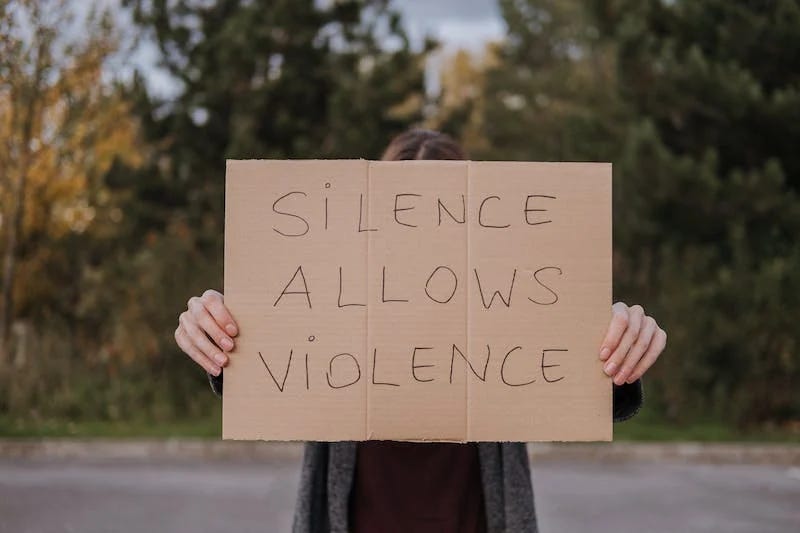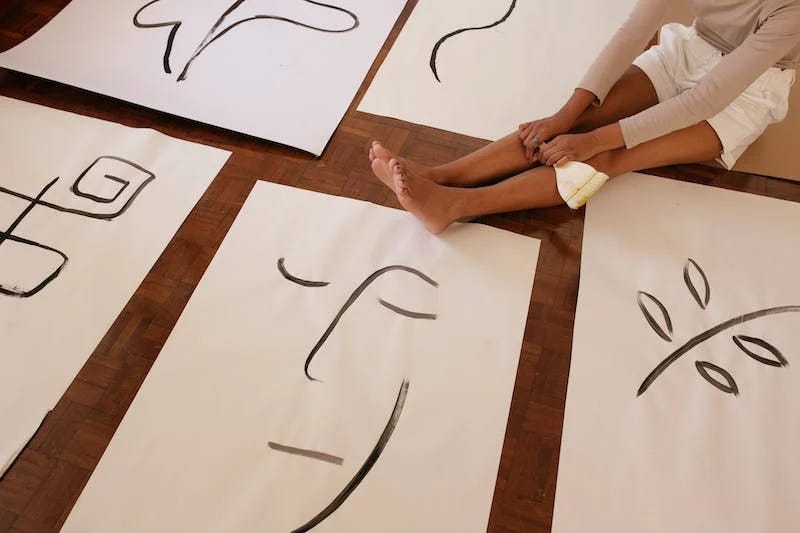🍄 Speechless: A Staggering Loss of Language
A mass extinction of languages? Up to 90 percent of the world’s languages will disappear by the end of the century. Lost Voices? It’s time to speak up.
Exploring every rabbit hole there is for the past 30 years. For more wanderings, become an Alice in Futureland subscriber—it's free.
🍄 AudioDose: this is Alice on Sonic Mushrooms. Children of the Solar System, listen here.
🎧 Alice in Futureland podcasts
📘 Alice books: Tuning into Frequency: The invisible force that heals us and the planet
Hello, we’re Alice, and we are always in a state of wander. “No biologist would dare suggest that 50 percent of all species or more have been or are on the brink of extinction because it simply is not true,” said National Geographic Explorer Wade Davis in his revered and revelatory 2003 TED Talk, ‘Dreams from endangered culture.’ “And yet that—the most apocalyptic scenario in the realm of biological diversity—scarcely approaches what we know to be the most optimistic scenario in the realm of cultural diversity. And the great indicator of that, of course, is language loss.”
Wade Davis coined the term “ethnosphere” to describe the web of human culture around the planet. He called it the "sum total of all thoughts and intuitions, myths and beliefs, ideas and inspirations brought into being by the human imagination."
Twenty years later, 2023, and the world’s dominant languages continue to expand at the expense of Indigenous languages. Linguists suggest that most of the 7,400 global languages are not recorded in writing, and unlikely to survive the end of the 21st century. From Hawaii to the Himalayas, Bangladesh to Brazil, Indigenous communities attempt to spark lost language through immersive education and language-learning programs. Even AI chimes in—but can it beat the ticking clock?
“The biggest thing you need in language revitalization is for people to choose to use the language, and technology can’t do that — it can’t change the fabric of society, but it can give people more tools,” X’unei Lance Twitchell, a professor of Alaska Native languages at the University of Alaska Southeast told Juneau Empire.
Voices, Hearts and Plans
In December the United Nations (UN) launched the Indigenous Languages Decade [2022-2032] to raise global awareness about the critical situation of Indigenous languages and their vitality for sustainable development. “Indigenous Peoples are guardians to almost 80% of the world’s remaining biodiversity, yet every two weeks, an Indigenous language dies,” said the UN general assembly president, Csaba Kőrösi.
The campaign aims to preserve, revitalize and promote Indigenous languages. “This is important precisely as languages are vectors of knowledge and carriers of identity,” said Kőrösi. “Knowledge that is invaluable, not only to the communities it belongs to, but to the whole of humanity. Because, to use a famous old adage, ‘language is the dress of thought’. With each Indigenous language that goes extinct, so too goes the thought: the culture, tradition and knowledge it bears. That matters because we are in dire need of a radical transformation in the way we relate to our environment.”
A new University of Zurich study suggests that language loss will be even more critical to the extinction of medicinal knowledge than biodiversity loss. "We found that more than 75 per cent of all medicinal plant services are linguistically-unique and therefore only known to one language," says senior researcher Rodrigo Cámara-Leret, co-author of the study, “Language extinction triggers the loss of unique medicinal knowledge.” Cámara-Leret and professor of ecology, Jordi Bascompte, analyzed 3,597 medicinal species and 12,495 medicinal applications associated with 236 Indigenous languages in North America, northwest Amazonia and New Guinea. “The next steps, in line with the vision of the UN, will require mobilizing resources for the preservation, revitalization and promotion of these threatened languages," says Bascompte.
Word Search
Today, 61 percent of languages around the world that were spoken as a first language in 1795 are doomed or extinct, reports The Language Conservancy, a group founded in 2005 by Indigenous educators and language activists in reaction to the severe decline of Indigenous language speakers in the United States. Nine languages a year, or one every 40 days, cease to be spoken. By 2080, the rate will rise to 16 languages per year. In the case of Latin America and the Caribbean, one in every five Indigenous peoples have already lost their native tongue: 44 of these peoples now speak Spanish and 55 Portuguese. “When a speech community dies, the world loses a bundle of ideas unique to that culture and a circle of concepts that could only be expressed in that language. The stories that once brought countless generations of a community together never again quicken hearts and minds.”
Knowledge Holders
“We are heading for a catastrophic language and cultural loss into the next century,” Dr. Gregory Anderson, director of the Living Tongues Institute for Endangered Languages, a non profit based in the US, told The Guardian. He notes that the death of a language is often the result of “some sort of assault” on Indigenous communities. Climate change, for example, puts small linguistic communities that live on islands and coastlines at risk.
Loss of language impacts not just culture, identity and mental health but also the future of medicine. The destruction of aboriginal languages means that medicinal science loses potential plant cures as language allows Indigenous societies to use their surrounding biodiversity as a “living pharmacy.” “Medical science loses potential cures,” Nancy Rivenburgh wrote for the International Association of Conference Interpreters (via the Smithsonian Magazine) “Resource planners and national governments lose accumulated wisdom regarding the management of marine and land resources in fragile ecosystems.” And the world’s dominant languages—or what are often called ‘metropolitan’ languages—are all now rapidly expanding at the expense of ‘peripheral’ Indigenous languages. Those peripheral languages are not being replaced.”
With the loss of Indigenous languages, inevitably a collection of environmental, technological, social, economic and cultural knowledge disappears that its speakers have accumulated and codified over millennia. “We are at this literal cusp in history where we could be losing half of our legacy, but that does not have to happen,” said Davis. “These cultures aren’t destined to fade away, as if by natural law. In every case they have been driven out of existence by identifiable forces and that’s actually an optimistic observation because if human beings are the agents of cultural destruction, we can be the facilitators of cultural survival.”
Speechless: How Did We Lose Language?
“When people say, ‘why does it matter, cultural diversity,’ and they say, ‘wouldn’t it be better if we all just spoke one language?’ My response is always to say, ‘That’s a great idea. Let’s make it Cantonese. How about Lakota? How about Yuruba? Yanomami, Hokan, Chichewa? French, even?’ And suddenly they blanch. The point is that language represents so much. It’s not just a bunch of vocabulary and grammar, it’s a whole reflection of a whole way of thinking. When I’m talking about diversity, I’m talking about the whole sweep of biological and cultural diversity of the planet.”—Wade Davis, ALICE interview
A language becomes dormant or extinct when no one can speak it anymore. By 1920, centuries of language loss had already claimed as many as half of the Indigenous languages of Australia, the United States, South Africa, and Argentina. “The languages of these countries faced a losing battle with settlement colonization that uprooted Indigenous peoples from their homes and led to language loss. Areas of the world that instead experienced exploitative colonization, the plundering of resources but not resettlement, did not face such a wave.”
Over the course of history, languages have disappeared for a variety of reasons. “Some languages died abruptly with the premature deaths of their speakers, by diseases brought by Europeans to North America,” writes First Voices, an online space for Indigenous communities to share and promote language, oral culture and linguistic history. “In some areas heavy losses resulted from warfare. In recent time languages were lost as people used the language of a dominant society in place of their mother tongue.”
Now, people voluntarily migrate from ancestral lands to cities where they speak the dominant language to take part in the economy. Historically, it was forced resettlement. “Government policies especially in the United States, Canada, and Australia aimed to strip peoples of Indigenous identity through education into the larger, national cultural identity,” writes The Language Conservancy. This also took place in Scandinavian nations. ”Boarding schools for children aimed to assimilate and acculturate, in large part by preventing the youngest generation from speaking their native languages. This slowed and eventually stopped the intergenerational transmission of many languages, dooming them.”
Survival of the Vocal
A study published in PNAS showed that regions with high levels of biodiversity also contain a vast amount of the world’s linguistic diversity. “Of the nearly 7,000 languages on Earth, more than 4,800 of them are spoken in those areas of high biological diversity,” writes Shayla Love for Vice. “This means that almost 70 per cent of languages are spoken on about 25 per cent of the Earth’s surface—the very same areas where species are concentrated. Many of those languages are facing extinction, just like the species that live there.”
Larry Gorenflo, a geographer and professor at Penn State University and the first author of the PNAS paper, recounted an example in Brazil, where Soybean agriculture currently encroaches on a Brazilian grassland area called the Cerrado, where there are 216 Indigenous territories and 83 different ethnic groups, as well as more than 4,800 species that aren't found anywhere else in the world. “There’s a lot of the natural habitat that Indigenous people, who were speakers of Indigenous languages, would have relied upon that isn’t there anymore,” Gorenflo said. “So they’ve moved away, or in some cases, they’ve converted in a sense—become more westernized and in the process have lost languages.”
“Once linguistic diversity is lost, its not easily recovered,” says Claire Bowern, a professor of linguistics in Yale University’s Faculty of Arts and Sciences. “It will take sustained efforts to document and revitalize endangered languages to avoid a devastating loss to the communities where these languages are part of the cultural fabric.” Bowern co-authored a recent study of global linguistic diversity, published in the journal Science Advances, showing the threat that language loss poses to humanity’s collective knowledge of history, culture and cognition. It’s the first study to use Grambank—the world’s largest and most comprehensive database of language structure—to better understand global linguistic diversity.
Grambank captures 195 language properties—including word order, verbal tense, and whether a language features gendered pronouns—allowing researchers to draw comparisons between and across the languages. “Grambank is like a DNA code of languages,” says Bowern. “We can use it to make comparisons to build language trees or examine how languages that split from a common ancestor differ from each other.”
Resurrection and Remedy
Many Indigenous communities are laboring to revitalize languages before they are lost. In Wisconsin, an Ojibwe language school called Waadookodaading (meaning, “a place where people help each other”) immerses its students in the environmental knowledge embedded in the language.
More than 18,700 people speak Hawaiian today due to immersion schools, compared to 2,000 native speakers in the 1970’s. In New Zealand, over 25% of young Māori people speak the language compared to just 5% in the 1970s. “Indigenous languages are an anchor to the past, as well as a compass to the future,” says Prof Rawinia Higgins, a member of the Global Taskforce for the International Decade of Indigenous Languages 2022-2032 and the New Zealand Māori language commissioner. “Once banned and seen by many as worthless, now more than eight in 10 of us see it as part of our identity as New Zealanders.”
Kanien'kéha is a language of the Iroquoian family, spoken primarily in Quebec, Ontario and New York State, and recognized for its rich repertoires of oratorical styles. “It is remarkable that under such highly unfavorable circumstances our language survived up to now,” writes First Voices. “Unfortunately, the number of Kanien'kéha speakers is very low. 140 speakers are left in Kanehsatà:ke. Efforts to save the Kanien'kéha language continuously evolve.”
Mental Hope on the Horizon
Language use and language revitalization in Indigenous communities results in significant, positive health outcomes, says a new review of 130 language studies.
“Health effects of Indigenous language use and revitalization: a realist review”, published in the International Journal of Equity in Health last year, calls these languages "the vessel that most efficiently carries these cultural lifeways." The study emphasizes that Indigenous culture and community are centered around common practices, writes study co-author, linguist Douglas Whalen, PhD. “We've seen it over and over in our Endangered Language Fund grantees: When Tribal Nations have the resources to create sustainable language and cultural revitalization programs, those programs feed physical, emotional, and spiritual needs. In the studies we reviewed, we see common positive health outcomes such as connection with traditional lifeways, increased physical activity, better school performance, and increased community involvement."
Enter the AI Chatbot
Can AI aid the lost language? Not so fast. ‘ChatGPT Is Cutting Non-English Languages Out of the AI Revolution,’ reports Wired. ‘AI chatbots are less fluent in languages other than English, threatening to amplify existing bias in global commerce and innovation.’ Thien Huu Nguyen, a University of Oregon computer scientist tells Wired: “One of my biggest concerns is we’re going to exacerbate the bias for English and English speakers. People are going to follow the norm and not think about their own identities or culture. It kills diversity. It kills innovation.”
🦋 Cultural Cartography
ALICE believes that studying how we use language, what words and phrases we connect can help us better understand how we envision our future. Language is a cultural, social and psychological roadmap. From the very beginning of human existence, humankind has relied upon symbolic metaphors to help bring meaning and purpose to their lives. Today, there is a misunderstood shift growing in society that is propelling divisive rhetoric about declining values. The opportunity for us today is to stop and listen to diverse narratives - narratives that can help us discover what is universal about languages to understand the core of our humanity. Understanding why and how languages differ uncovers our potential of what it means to be human. To quote Noam Chomsky: “A language is not just words. It's a culture, a tradition, a unification of a community, a whole history that creates what a community is. It’s all embodies in a language.”
What Else We Are Wondering…
🧠 Are your politics influenced by the language you speak?
A new book Voicing politics: How language shapes political opinions [Princeton University Press, 2022] uncovers the ways in which linguistic peculiarities of different languages can impact political attitudes and beliefs around the world.
🧠 Endangered Language Learning App
An EU funded project released a language learning app called IndyLan, encouraging English, Spanish, Norwegian, Swedish and Finnish speakers to learn endangered languages like Northern Saami, Gaelic, Scots, Cornish, Basque and Galician.
🦋 "If you talk to a man in a language he understands, that goes to his head. If you talk to him in his own language, that goes to his heart.”—Nelson Mandela
Craving more?
📘 Alice in Futureland books
🎧 Alice in Futureland podcasts
👁🗨 Polychromatic World with Wade Davis
👁🗨 Ethnosphere with Wade Davis
Thanks for tuning in.
For more wanderings, become an Alice in Futureland subscriber—it's free.
Invite your friends to this mad tea party and let's see how many things we can learn before breakfast.
©2023 Alice in Futureland








